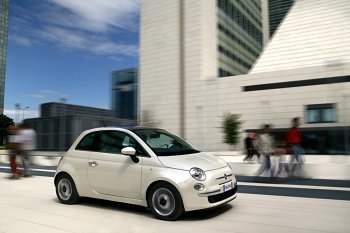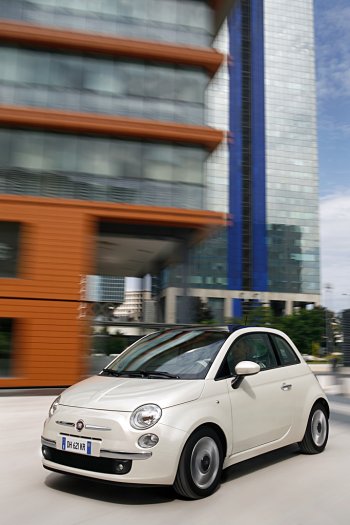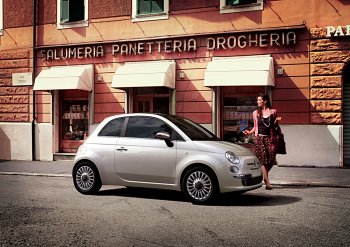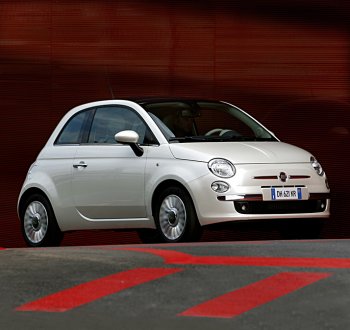|
CLASS BEATING
SAFETY
|
|
The Fiat 500
does not only offer styling with plenty of personality,
modern, reliable engineering, lavish equipment and
outstanding comfort. It is also an extremely safe car. More
than individual devices it is a combination of various
systems that make it one of the safest cars in its segment.
The new model is the first car in this category to offer up
to 7 airbags (front, side, curtain- and knee-bags are all
standard throughout the range, except for the Naked
version). And the new 500 also proposes a number of
sophisticated technical solutions to control the car’s
dynamic behaviour. They include ABS complete with EBD, the
sophisticated ESP (Electronic Stability Program), ASR (Anti
Slip Regulation), HBA (Hydraulic Brake Assistance) and a
Hill Holder device. And to guarantee the safety of the
occupants, the bodyshell of the new model is designed to
respect all the latest impact resistance criteria (it is the
first super-mini with a front structure designed
specifically to improve compatibility between vehicles in a
head-on impact), and is rigid around the passenger
compartment to protect occupants with high-absorption areas
on the outside. Seat-belts with double pretensioners and
load limiters are standard on the front seats, with
three-point belts at the rear. The front and rear seats are
fitted with antisubmarining devices that prevent the
occupant from sliding forward, under the seat-belt. Isofix
attachments for child seats are standard throughout the
range.
The Fiat 500 is fitted with all the dynamic and comfort
features that ensure occupants can tackle any type of road
comfortably and safely. The credit also goes to the
suspension: an independent MacPherson system at the front,
and semi-independent interconnected wheels with a torsion
axle at the rear. The two layouts have evolved from a
Magneti Marelli design and have been used on other Fiat
models in the past; they have now been revised and modified
for the new car, to guarantee outstanding handling and the
highest possible level of comfort.
Active safety
The braking system on the new car has two independent
cross-over circuits to guarantee prompt, smooth braking and
shorter stopping distances. The pedal has a short stroke, so
that the characteristics of the servo assist are exploited
in full. The front discs have a diameter of 240 mm; they are
solid for versions with the 1.2 8v engine and ventilated for
the 1.3 Multijet, with a diameter of 257 mm for versions
with the 100 bhp 1.4 16v. The rear brakes mount drums (180
mm) on the 1.2 8v and 1.3 Multijet, and discs (240 mm) on
the 1.4 16v. The 9” brake servo makes braking easier and
more effective, decreasing the effort needed on the pedal.
ABS system
The ABS on the Fiat 500 has four active sensors, four
channels, a hydraulic control unit with eight solenoids and
comes complete with EBD (Electronic Brake Distribution). The
system can guarantee the best possible braking effort even
with each wheel close to locking, which means it is possible
to control the direction of the car fully in emergency
situations using the steering wheel. The strong points of
the system are the active sensors, which process the wheel
speed data themselves (without having to send them to the
control unit); they can read values very close to nought
(passive sensors do not register speeds below 2.5 km/h) and
are less sensitive to disturbance caused by electromagnetic
fields. This advanced ABS system is supplemented by
electronic brake force distribution, EBD, which distributes
the braking force between the front and rear wheels to
prevent the rear wheels from locking, guaranteeing a
balanced response from the car in all conditions. The system
also adapts to the grip conditions of the wheels and the
efficiency of the brake pads, and it reduces the temperature
of the front brakes and the effort demanded from the brake
servo.
ESP (Electronic Stability
Program)
The new Fiat 500 offers the sophisticated Electronic
Stability Program to guarantee complete control over the
car; this program cuts in when conditions are close to the
limit, and the car’s stability is at risk, to help the
driver to control the vehicle (the device is standard with
the 1.4 engine and an option with the other two). To do so,
ESP constantly verifies how the tyres grip the ground,
longitudinally and laterally, and if the car does skid, it
cuts in to recover the trajectory and trim stability. It
incorporates sensors that measure the wheel speed, the
vehicle’s rotation around its vertical axis (yaw speed), the
lateral acceleration and the steering angle set by the
driver (which indicates his chosen direction). It then
compares these data with the parameters processed by a
computer and uses a complex mathematical model to establish
whether the car is taking a bend within the grip limits, or
whether the front or rear is about to veer (understeer or
oversteer). To bring it back to the correct trajectory, the
system generates a yaw moment opposite to the one that
caused the instability, singly braking the appropriate wheel
(nearside or offside), and reducing the engine power by
adjusting the throttle valve.
|


 |
|
The new model is the first car in this category to
offer up to 7 airbags (front, side, curtain- and
knee-bags are all standard throughout the range,
except for the Naked version). |
|
|
 |
|
The Fiat 500 does not only offer styling with plenty
of personality, modern, reliable engineering, lavish
equipment and outstanding comfort. It is also an
extremely safe car. |
|
 |
|
|
 |
|
|
 |
|
|
|
This is where the device developed for the
Fiat 500 differs from other systems. Its intervention on the
brakes is modulated to be as gentle as possible (therefore
without disturbing the driving), and the reduction in engine
power is limited, to guarantee excellent performance and
enjoyable driving at all times. ESP is always engaged.
ASR (Anti Slip Regulation)
and MSR (Motor Schleppmoment Regelung)
To limit any slipping of the driving wheels when grip on the
road is poor, the new Fiat 500 is equipped with a
sophisticated device that controls traction automatically.
It is known as ASR (Anti Slip Regulation), and is standard
equipment on all versions that mount the ESP system. ASR
functions at all speeds and adjusts torque on the basis of
the grip detected.
Based on the number of wheel revs calculated by the ABS
sensors, the device calculates the degree of slipping and
activates two different control systems to recover grip:
when an excessive demand for power causes both drive wheels
to slip (for example when aquaplaning or accelerating on an
uneven, snow-covered or icy road surface), the system
reduces engine torque by decreasing the throttle valve
aperture and thus the air flow; if only one wheel slips (for
example the wheel inside a bend following acceleration or
dynamic changes to the load), this is automatically braked
without the driver having to press the brake pedal. The
effect obtained is similar to that of a self-locking
differential.
ASR helps to maintain vehicle stability, and it is
particularly useful when there is a loss of grip (just think
of the ramps in a garage in Winter) and when the paving does
not guarantee homogeneous friction. Another advantage of ASR
that should not be overlooked is the reduction of stress on
mechanical organs such as the differential and gearbox,
which is achieved by controlling take-off and traction at
low speeds. ASR is engaged automatically every time the
engine is started, but can be excluded by a switch on the
centre console. When ASR is activated a telltale on the
instrument panel flashes. If the telltake in the control
panel comes on, but the LED on the switch is off, this
indicates a malfunction or irregularity in the system. ASR
must be de-activated when snow chains are mounted, because
in order to transmit torque to the ground, the wheel has to
be able to ‘pile up’ snow with small slips that the ASR
system tends to avoid. If the driver changes down suddenly
and grip is poor, the MSR device (Motor Schleppmoment
Regelung) takes over, returning torque to the engine and
preventing slipping due to wheel lock.
HBA (Hydraulic Brake
Assistance)
The Fiat 500 adopts a device that assists in emergency
braking. On cars fitted with ESP this function is performed
electronically by the ABS control unit and it is called HBA
(Hydraulic Brake Assistance).
During ‘panic’ braking, most drivers recognise an emergency
situation and put their feet down very rapidly on the brake
pedal, but not with the necessary additional effort.
Because, unless he is a professional driver, the motorist is
accustomed to braking by applying a certain ‘load’ to the
pedal, and like all automatic gestures repeated over and
over again, he tends to use the same effort in all
circumstances. On the new model, at this point the Brake
Assist devices are triggered, and although the pressure on
the pedal remains the same, they ensure the same
deceleration that you would achieve by braking with every
possible force.
The panic braking assist is also useful for more expert
drivers who do brake rapidly, and with the right amount of
energy when necessary. Because in any case the system
reduces braking implementation time, i.e. the time between
the moment he applies the force on the pedal and the moment
that the circuit reaches maximum pressure and can give its
best performance.
Hill Holder
The Hill Holder is a system that helps the driver on hill
starts. It cuts in when the ESP control unit perceives a
difference in the inclination of the car through a
longitudinal acceleration sensor on the floor under the
front passenger seat. During a hill start, the control unit
prepares to intervene when first speed is engaged and the
brake and clutch pedals are depressed. The pressure on the
front brake callipers is maintained for about 2 seconds
after the driver releases the brake pedal, allowing him to
set off without difficulty. The Hill Holder is not activated
when the car is started downhill with first speed engaged.
Similarly, when reverse is engaged, the system is activated
for downhill starts, and it is not activated for uphill
starts. |
|